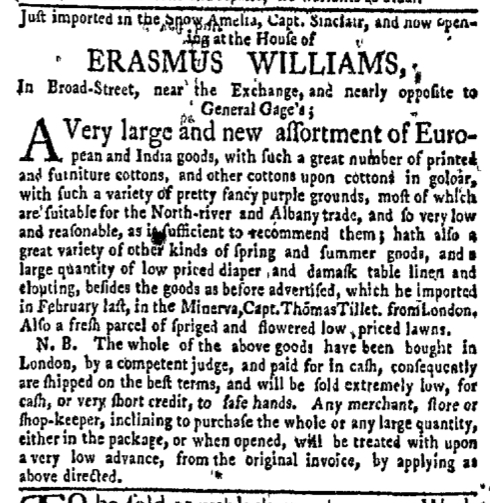What was advertised in a colonial American newspaper 250 years ago today?

“Most of which are suitable for the North-river and Albany trade.”
Although Erasmus William’s advertisement in the May 9, 1768, edition of the New-York Gazette and Weekly Mercury did not discourage or exclude retail sales, it did focus primarily on further distributing imported goods by offering to sell to merchants and shopkeepers wholesale. Williams reported that he had just received “A very large and new assortment of European and India goods” via “the Snow Amelia, Capt. Sinclair.” The merchant proposed specific customers for many of the textiles, especially the “great number of printed and furniture cottons.” He stressed that they were “suitable for the North-river and Albany trade.” Since the newspapers published in New York served the entire colony, he had a reasonable expectation that potential buyers from far beyond the city would see his advertisement and possibly contact him to refresh their inventories.
Williams also directly addressed prospective customers who might wish to buy in bulk, pledging that “Any merchant, store or shop-keeper, inclining to purchase the whole or any large quantity” would get a real bargain. He explained that an associate in London, a “competent judge” of the merchandise, had negotiated a deal and paid for the goods in cash. In turn, this allowed Williams to pass along the savings to his own customers, especially those interested in relieving him of significant quantities all at once.
Most merchants who placed advertisements for consumer goods in eighteenth-century newspapers did not explicitly specify that they intended to sell their wares wholesale. Some likely assumed that readers already knew which advertisers were wholesalers and which were retailers. Williams, on the other hand, made it clear that he intended to sell “the whole” or a large quantity in a single transaction. He also imagined the further distribution of the assortment of goods he had just imported, envisioning that they would be transported beyond New York, a busy port city. The consumer revolution of the eighteenth century was not confined to the urban centers on the Atlantic coast. Instead, merchants like Williams and the shopkeepers and other traders that did business with him in other parts of the colony helped facilitated the expansion of consumer culture to towns and villages and beyond.
